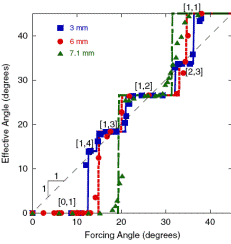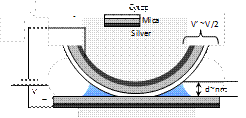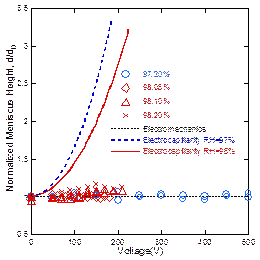AmericanChemicalSociety.com
Reports: G5 46510-G5: Application of an Electric Field to Control Wetting of Thin Fluid Films
Joelle Frechette, Johns Hopkins University
Overview:
The ACS-PRF grant (type G) has helped support two separate projects over the last two years. The focus of the first project was to understand the importance of particle-obstacle interactions in a microfluidic separation method called deterministic hydrodynamics. The goal of the second project was to understand the mechanism driving electrowetting on dielectric for nanoscale systems. The ACS-PRF-supported work has led to additional funding from the National Science Foundation and 3M Corp., as well as long-term collaboration with other researchers. The Type G grant has also had a large impact on my own career via support of summer salary. Additionally, the research results have resulted in three published manuscripts and one more to be submitted.
Summary of Activities:
Project 1) Directional locking
The potential technological impact of lab-on-a-chip technologies for analytical chemistry has propelled the need for separation methods that are rapid, effective, and continuous1-4. One strategy to achieve separation in microfluidic devices has been the miniaturization of well-established macroscale methods (such as hydrodynamic chromatography). While effective, these techniques are characterized (and limited) by the random nature of the pore space, which implies that the separative displacement of different species is the average behavior of an inherently stochastic process. Alternatively, microfabrication has opened the door to new concepts for separation, such as deterministic hydrodynamics, in which the components being fractionated become locked into size-dependent periodic trajectories that exhibit lateral migration as they travel through an array of obstacles. However, the separation principles involved in deterministic hydrodynamics are not well-understood. The proposed mechanism is based on the streamlines followed by a simple fluid at low Reynolds numbers (Stokes flow) and in the absence of suspended particles5-7. Thus, it does not include hydrodynamic or non-hydrodynamic interactions between the particles and the obstacles, or possible inertia effects. A better understanding of the phenomena underlying the observed separation was needed to develop further this promising method.
Achievements. We conducted simple experiments using a large array of obstacles and a uniform driving force (gravity) to explore the deterministic nature of the deterministic hydrodynamics separation method8. We investigated the motion of stainless steel balls falling through a periodic array of obstacles created with cylindrical LEGO® pegs on a LEGO® board and immersed in a tank filled with glycerol (Fig. 1). We showed that the motion of the spheres was irreversible and displayed directional locking (Fig. 2). We also demonstrated that the locking directions could be predicted with a single parameter that distinguishes between reversible and irreversible particle-obstacle collisions9. These results stressed the need to incorporate irreversible interactions to predict the movement of a sphere passing through a periodic array. Interestingly, even though the resulting lateral displacement is typically small, the periodic nature of the system allows such lateral displacement to accumulate, thus amplifying the effect into a macroscopic change in the migration angle. Therefore, by controlling weak, short-range, nonhydrodynamic forces, such as electrostatic forces, microfluidic devices employing periodic arrays should be able to enhance the separation of species.
Project 2) Thin film electrowetting
Fig. 3. Macroscale electrowetting on dielectric (EWOD). | Fig. 4. In nanoscale EWOD, the potential across the surfaces causes the meniscus height to change. |
Our efforts in nanoscale capillarity are to understand, from a fundamental perspective, the role of an electric field on the stability, and tunability of liquid bridges in confined geometry. The surface force apparatus (SFA) was employed as a testbed in concert with external fields. The SFA allowed the channel height to be varied continuously without changing the surfaces, allowing systematic and quantitative evaluation of the control of surface interactions at the nanoscale.
Achievements: While electrowetting (Fig. 3) is a phenomenon is relatively well-understood for large (mm) fluid drops, the limits of traditional theories for a fluid drop in a nanoscale channel have not been tested experimentally. Moreover, the mechanism at play during electrowetting is not fully understood and the origin of anomalous features such as contact angle saturation remained debated. Two different approaches originating from different mechanisms (electrocapillarity and electromechanics) have been used to describe the observed change in apparent contact angle in electrowetting. Interestingly, these completely different theories lead to the same macroscopic response (i.e. the relationship between contact angle and voltage is the same), which has made it difficult to unequivocally explain the observed behavior.
Fig. 5. Height of a condensed meniscus measured as a function of the applied potential. The line corresponds to theoretical fits. (Langmuir, 26, 11946-11950, 2010) |
Using the SFA, we have designed experiments to test the mechanism driving electrowetting (Fig. 4). We have modified the instrument to allow for external potential control of both interacting surfaces and used capillary condensation10 to generate nanoscale water droplets. Our experiments allowed us to probe contact angle changes within the first tens of nanometer of a drop, and are not limited by possible issues caused by contact angle hysteresis. Using this approach we have unequivocally demonstrated that the real contact angle does not change in electrowetting experiments. Our results show that there is no measurable change in the solid-liquid surface energy in EWOD and that the mechanism at play is electromechanical in nature (see Fig. 5).
1. MacDonald, M. P., et al., Nature 2003, 426, 421.
2. Yager, P., et al., Nature 2006, 442, 412.
3. Janasek, D., et al., Nature 2006, 442, 374.
4. El-Ali, J., et al., Nature 2006, 442, 403.
5. Davis, J. A., et al., Proc. Natl. Acad. Sci. U. S. A. 2006, 103, 14779.
6. Huang, L. R., et al., Science 2004, 304, 987.
7. Korda, P. T., et al., Phys. Rev. Lett. 2002, 89, 128301.
8. Balvin, M., et al., 2009, 103.
9. Frechette, J.; Drazer, G., J. Fluid. Mech. 2009, 627, 379.
10. Israelachvili, J. N., Intermolecular and Surface Forces with Applications to Colloidal and Biological Systems. Academic Press: London, 1985.
Copyright © American Chemical Society







